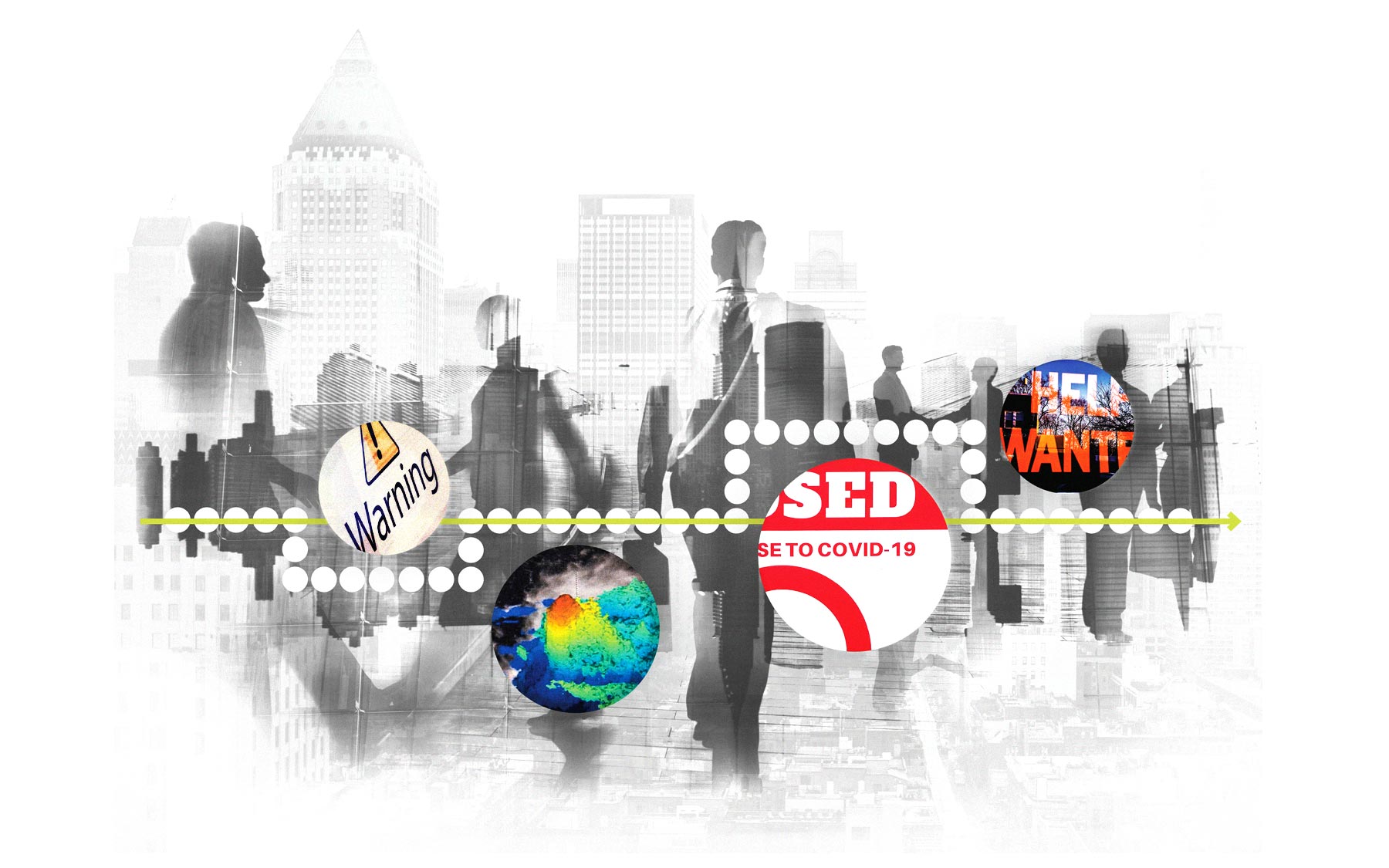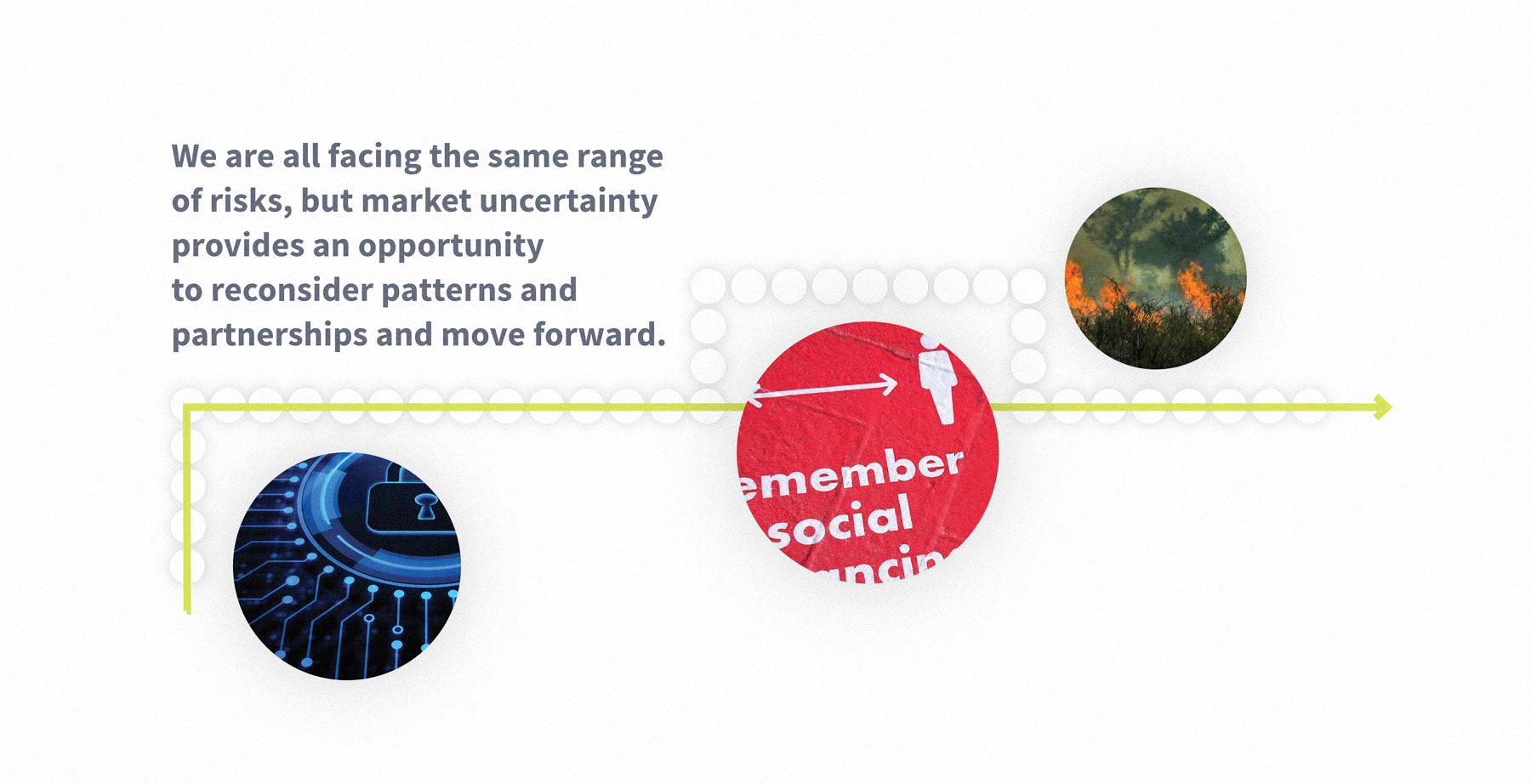CONTRIBUTORS
ERIC MALTERRE
chief client officer, international, Sedgwick
JAMES NORMAN
international business development director, Sedgwick
The predominant global business risks will always vary from country to country. But on a macro level, the list of current concerns is oddly similar, including rising inflation, ongoing supply chain disruptions, cyber events, political discord and the fight for talent, which continues to have a ripple effect on workforces around the world.
In February 2022 alone, Storm Dudley and Storm Eunice caused havoc across Europe, historic flooding hit eastern Australia, 83 breaches and cyberattacks were recorded globally, and crushing sanctions were imposed on Russia following its assault on Ukraine. Managing marketplace unpredictability has never been more challenging.
So, what does the future look like and how can we be prepared to respond? What changes can we expect to see in insurance claims management over the next few years?
Time for change
The whole world is going through a period of uncertainty. From geopolitics to climate change to fears around another pandemic outbreak… instability seems prevalent everywhere. But with disruption comes the opportunity to step back and take a wider view of what’s working — and what isn’t — within claims management programs, and then reimagine the process.
Change innovation requires proactive interaction, with service providers, brokers and internal teams collaborating to understand accurate exposures. If there’s one thing the COVID-19 crisis has taught us, it’s that risk awareness and readiness have never been more important.
As you consider your business, ask yourself: Are we prepared to deal with the next big catastrophic event, and are we satisfied with the level of data and insurance cover? If the worst happens, do we know where to go to manage the situation? Do we have strong service partner relationships? Are we getting good service?
Whether clients are considering insourcing or outsourcing, they’re looking at service providers for a reason. Either we can do something they can’t, or we can do it more effectively.
Reimagining claims programs
Historically, claims management contracts have been price-driven, with strict service level agreements and KPIs; this is changing. Now, the focus is more on developing holistic, partnership-based relationships, where service providers listen and work with clients to identify pain points and design a whole new approach with the objective to improve the customer experience and drive efficiencies. And through the introduction of intelligent systems and streamlined processes, the customer experience is improved and claims management costs are reduced over time. Of course, the price pressure is still there, but cheapest doesn’t always win.
A more collaborative approach and the availability of new technology is changing the way risk managers look at big complex claims management programs — it’s more about leveraging the best in people, data and insights. Clients want a program structure they can be confident in, one that supports their customers in a crisis while protecting their reputational risk and brand.
Cultural fit
In handling customer claims on behalf of insurers, service providers play an important role in retaining and growing their clients’ business. They have to align themselves with, and become an extension of, their clients’ operations and embed themselves into the company. It’s the best way to understand and appreciate their claims philosophy.
Unsurprisingly, clients want to work with partners with similar core values, brand and market reputation — they have to be the right cultural fit. Today, there is an increasing emphasis on a robust environmental, social and governance (ESG) strategy, with most clients expecting service partners to evidence a carbon-neutral footprint. Managing the knowledge gap is increasingly essential, and a cohesive values-led culture should include a learning and development program that encourages next-generation talent.
Technology-enabled
While, ultimately, claims handling is all about understanding customers, solving their problems and providing an excellent claims experience, it’s no longer enough to have teams of skilled technical people who are very good at what they do. Digital solutions are great business enablers, and technology-enabled claims management service providers are entirely different to service providers that simply use technology.
Data analytics, data science, machine learning and artificial intelligence are all essential tools that add value, insight and reassurance. We process huge volumes of claims data every year, and through smart use of data analytics, we can track claims trends and see things as they happen. This helps mitigate risk and manage claims more effectively — it also highlights why long-term partnerships really work. And by investing talent and technology into the relationship, we can help measurably reduce risk exposure and future claims costs.
Global programs
While you can have great success developing long-term relationships with a client in one country, extending that to operations in other parts of the world isn’t always that straightforward.
Global companies rely on local teams and the ability to scale up when needed — and all within a compliant framework. The ability to look across the entire claims portfolio gives the insight you need to identify where the risks really are. It can also reveal what kind of issues the business could be exposed to. Armed with this information, you really can reimagine the claims management program globally and look at proactive measures, using data as an enabler to enrich insights and be much more effective.
Issues flex
Working with many different carriers, corporates and reinsurers, and across both mature and emerging markets, it’s crucial to have a holistic view of the claims landscape and adapt to meet local regulations and nuances. Cyber security in the post-pandemic workplace is an ongoing concern, exacerbated by the intensifying situation in Russia. But issues flex depending on the program coverage and exposure in multiple territories. In African countries, for example, the pandemic and rising cost of living are the current key issues.
Growing together
Whatever the program, it’s advantageous to be involved in any partnership at the very beginning. For example, new Lloyd’s syndicates and MGAs are currently positioned as disrupters, supporting the transformation of the London market as they aspire to grow into multi-territory, multi-product line businesses. They are looking for new ways of optimizing processes and need partnerships that add real value to what they aim to achieve. In this evolving environment, we cannot automatically assume we know what’s required and provide an overwhelming menu of options. We have to disaggregate the issues and offer a specifically designed solution. Data, tech and innovation are important, but not everyone has the same risk appetite and budget.
Catastrophe response
Climate change has made the world more volatile and unpredictable. Bigger and more frequent storms, as well as typhoons, hurricanes and bushfires, mean a transactional response is no longer enough. Getting boots on the ground is critical, and we’re more proactive in integrating technology and changing mindsets — technology isn’t just for small attritional claims. For example, when a massive hotel in the Caribbean was decimated, it could be verified and inspected using satellite and video technology.
The focus must also be on where human intervention is essential. People with customer-centric soft skills and trained to interact sympathetically with customers are part of the new generation of loss adjusters. Technical expertise remains paramount, but in an event of any size, customers need to trust in your ability and genuine desire to make things right. This is all part of a holistic strategic approach to claims management.
Knowledge gap
Attracting new talent into the loss adjusting industry has always been a challenge, but once people join, they rarely leave. There’s infinite variety, and every claim is different. You get to help people in all sorts of situations, work with large organizations, travel around the world — the scope is endless.
Our people are our best advocates. But as an industry, we need to put more effort into promoting the profession at a grassroots level; universities and career fairs are a good example of underutilized opportunity. Offer a great place to work, excellent career development pathways, comprehensive training programs and mentor support, and people will stay.
Change is needed
We are all facing the same range of risks, but market uncertainty provides an opportunity to reconsider patterns and partnerships and move forward. Transformation requires ongoing investment. It’s about playing the long game, where service providers constantly listen and provide solutions, and we grow together.
But is this a good time to step back and evaluate claims programs? In the current post-COVID market, more than ever, clients need reliable partners with global reach, local knowledge, technical skills, scalability, balance sheet strength and connectivity. And the best way to manage unpredictability is to have long-term relationships in place, so you’re ready to respond.
While many clients might be taking stock of their current position, there’s a definite reticence to make any dramatic changes until the market stabilizes. However, change is sometimes needed. And a period of instability creates the perfect opportunity to look at things differently and move with the times — take control, press the reset button and accelerate the process. Fast forward five years and the market will look different again.



